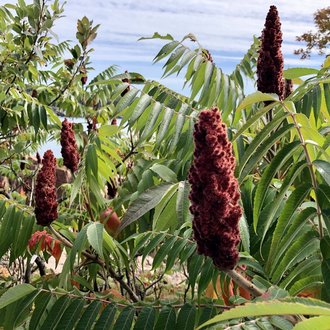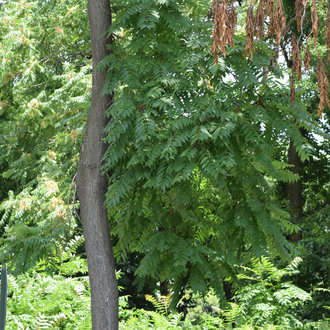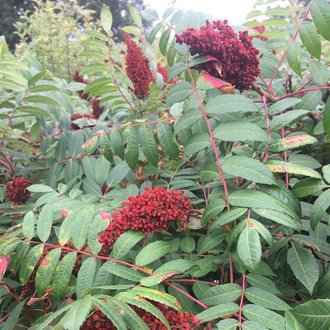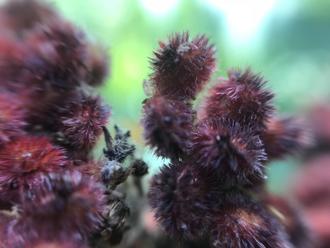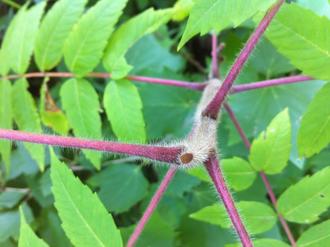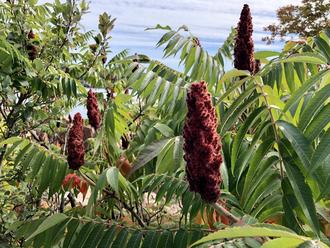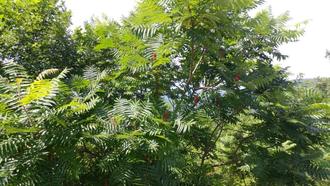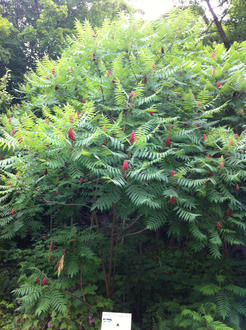Staghorn Sumac (Rhus typhina L.)
Also classified as Rhus hirta.
↑Summary
A thicket-forming shrub or small tree native to eastern North America; a pioneer species preferring rocky soils.
↑Range - Expand
| Legend | Color |
| Native | |
| Introduced or Not Present | |
| Native or Not Present | |
| Expanded | |
| Expanded or Not Present | |
| Native or Expanded |
This tentative map is based on our own research. It may have limited data on Canada and/or Mexico, and there is some subjectivity in our assignment of plants as introduced vs. expanded. Read more in this blog post.
Although this plant occurs somewhere in each of these regions, it may only occur in a small part of some or all of them.
This species is occasionally cultivated and can escape cultivation, but also spreads readily by bird-dispersed seeds and vegetative spread. There are numerous scattered introductions of this species west of its native range; we made an arbitrary judgment call about where to mark these expanded vs introduced, but there is no absolute correct choice here. Any of these populations could be marked introduced.
↑Description & Identification
A shrub or small tree to 40 feet, usually much shorter. Often thicket-forming, each individual plant having multiple trunks connected to a single root system. Alternate leaves are pinnately compound, and leaflets are serrated. Young twigs, petioles, and central stem of each leaf are densely hairy.
Fruits in a dark red cluster of berries, also covered in hairs.
↑Similar Plants
↑Habitat
Usually found on dry, rocky, or gravely soils, including ones low in organic matter. Tolerates average to very dry conditions, but intolerant of poorly-drained sites, and usually absent from richer sites due to competition from other species.
Primarily a pioneer species, found in early-successional habitats and recently-disturbed areas, including abandoned fields, roadsides and railroad tracks. Also sometimes found on recently-burned areas, and recently clearcut areas. Usually is eventually replaced by more shade-tolerant species, but can persist longer on forest edges and in areas where plant growth is limited, such as bedrock outcroppings.
Humans have greatly increased the habitat for this species through repeated mowing, and also through the placement of concrete, rock, and gravel, which provides better habitat for this species.
↑Life Cycle
Seeds germinate in exposed conditions and grow rapidly. Once established, plants spread vegetatively, forming large vegetative clones with multiple stems.
Female and male flowers are borne on separate plants. Although the growth rate of female and male plants are the same, male plants flower consistently, whereas female plants tend to have a mix of nonfruiting trunks and fruiting trunks, using energy from the vegetative trunks to support the flowering trunks.
Once established, seed production is high and relatively consistent year-to-year. Seeds are distributed by birds. Seeds often remain dormant and form a seed bank; germination is encouraged by heat.
Damage to above-ground parts of the plant stimulates root sprouting, but this species spreads vegetatively even in the absence of damage. Aboveground plant parts are highly susceptible to fire and can also be damaged by frost. The root system is often longer-lived than individual trunks.
↑Faunal Associations
Overall this species, like other sumacs, has high wildlife value.
Numerous small bees, wasps, and flies visit the flowers. Of these, little carpenter bees also nest in the pith of this and other sumac species. A large number of insects feed on the foliage and other parts of the plants, including larvae of various butterflies and moths, and various beetles and bugs.
Birds eat the fruit, but usually wait till winter when other food sources are scarce.
Deer and rabbits browse the foliage and stems during the growing season, and younger woody stems during the winter.
↑Uses
Occasionally used as a landscaping plant, where it is valued for its showy fruit, relatively small maximum size, tolerance of urban conditions, and picturesque growth habit. Often avoided in landscaping, however, due to its tendency to spread aggressively by its root system and repeatedly form new sprouts.
Also used, and very effective, for erosion control on slopes and areas with poor soil.
The fruit is occasionally used to make a drink. The berries are edible but need to be processed to remove the hairs; typically a cheesecloth is used to strain out the hairs.
↑Related Plants
This species is probably most closely related to smooth sumac (Rhus glabra), with which it overlaps in range and sometimes hybridizes, as well as with the rare and endangered false poison sumac (Rhus michauxii), which mostly does not overlap in range.
Also occurring in its range, but less closely related, is winged sumac (Rhus copallinum), and even less closely related, is fragrant sumac (Rhus aromatica).
↑Links & External Resources
• Sumac | The Wood Database (About This Site)
• Staghorn Sumac | Fire Effects Information System (FEIS) (About This Site)
• Rhus typhina (Staghorn Sumac) | USDA PLANTS Database (About This Site)
• Rhus typhina (Staghorn Sumac) | Missouri Botanical Garden Plant Finder (About This Site)
• Staghorn Sumac | Virginia Tech Dendrology Factsheets (About This Site)
• Rhus typhina | Biota of North America Project (BONAP) (About This Site)
• Rhus typhina | NatureServe Explorer (About This Site)
• Rhus typhina | Missouri Plants (About This Site)
• Staghorn Sumac | Maryland Biodiversity Project (About This Site)
• Rhus typhina L. (Staghorn Sumac) | Digital Atlas of the Virginia Flora (About This Site)



